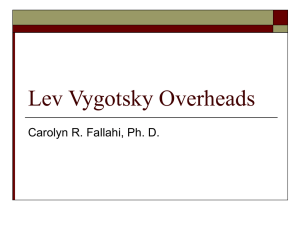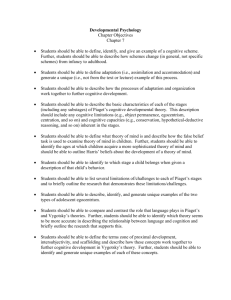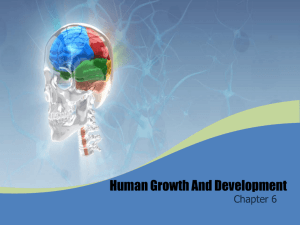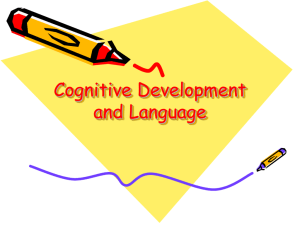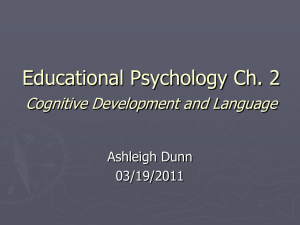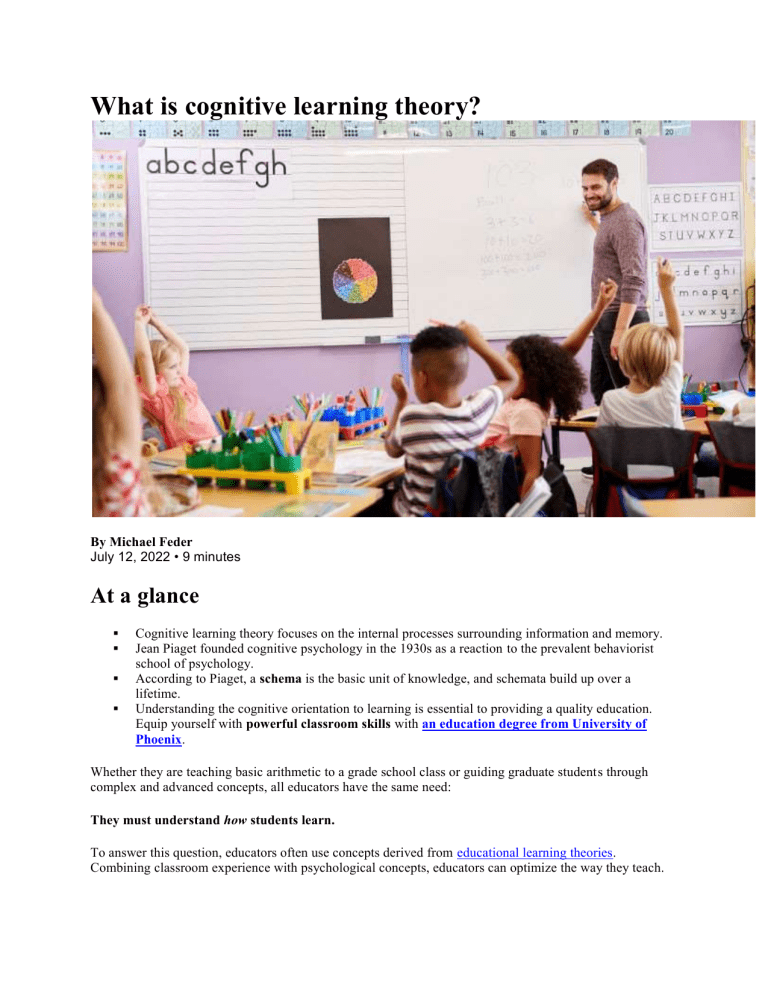
What is cognitive learning theory? By Michael Feder July 12, 2022 • 9 minutes At a glance Cognitive learning theory focuses on the internal processes surrounding information and memory. Jean Piaget founded cognitive psychology in the 1930s as a reaction to the prevalent behaviorist school of psychology. According to Piaget, a schema is the basic unit of knowledge, and schemata build up over a lifetime. Understanding the cognitive orientation to learning is essential to providing a quality education. Equip yourself with powerful classroom skills with an education degree from University of Phoenix. Whether they are teaching basic arithmetic to a grade school class or guiding graduate students through complex and advanced concepts, all educators have the same need: They must understand how students learn. To answer this question, educators often use concepts derived from educational learning theories. Combining classroom experience with psychological concepts, educators can optimize the way they teach. Cognitive learning theory, which focuses on the internal processes surrounding information and memory, is one of the most adaptable of the five major learning theories. Cognitive learning has applications for teaching students as young as infants, all the way up to adult learners picking up new skills on the job. For educators, understanding cognitive learning can help them develop effective lesson plans. For everyone else, the theory’s principles are helpful for understanding how the mind works and how to learn more effectively. Basics of cognitive learning theory At the center of the cognitive learning theory sits the concept of cognition, which Britannica.com defines as “all conscious and unconscious processes by which knowledge is accumulated, such as perceiving, recognizing, conceiving and reasoning.” “Knowledge,” as understood by cognitive theorists, is the cognitive processing of what something is and what something is not, from concepts as simple as a young student identifying animals from a picture book to something more complex such as weighing the pros and cons of eating meat. Psychologist Jean Piaget developed the first cognitive psychology theories in the 1930s from his work with infants and young children. Behaviorism, which was the prevailing psychological theory at the time, focused solely on behaviors that could be observed externally. Behaviorists argued that these behaviors were a result of a subject’s interaction with external events and actions. Piaget argued for something different. His research and writing focused instead on mental processes that occurred internally. He viewed human subjects as beings that not only react to the things around them but also process and store information related to those things. What's the difference between cognitivism and constructivism? Piaget’s work is also associated with the constructivist learning theory, which shares many concepts with cognitive learning. They both focus on the internal processes associated with learning, as opposed to outwardly observable behavior. To make the distinction clear, constructivists emphasize learners actively participating in building knowledge. For cognitivists, active participation is not necessarily important. Much of the knowledgebuilding process happens passively, according to cognitivists. In practice, cognitivists are not as eager as constructivists to discard lectures and textbooks in favor of more participatory teaching methods. What is constructivism in education? Read more Accommodation and assimilation in cognitive psychology Piaget saw human development as a multistage process of building knowledge. From their first breath, infants learn basic motor functions, like learning to grasp objects. By adulthood, these functions are essentially second nature, and people can grapple with concepts that are very complex, like philosophy or mathematics. To make a consistent psychological theory, Piaget sought to break knowledge (no matter how simple or complex) into a single, basic unit. From there, he could develop a theory of cognitive learning that could apply just as much to a baby’s first step to deep philosophical concepts they might develop later in life. Piaget called this basic unit schema. What are schemata? Here is how Piaget defines a schema: “a cohesive, repeatable action sequence possessing component actions that are tightly interconnected and governed by a core meaning.” Let’s break this down with a simple example: A child recognizes a cow on a farm. The “cohesive, repeatable action” is the child’s recognition of the cow. It is repeatable in that that the child will continue to recognize it (and animals identical to it) as a cow. This action of recognition can be broken down into its components: The child doesn’t just see a cow. They see a thing that is alive, has four legs, is eating grass and makes a mooing sound. These acts of recognition, of course, can be broken down further. The child must have some concept of what a live thing is, how to count to four and so on. For the child, all these various components form the “core meaning” of a cow. Even when the child leaves the farm, they will still have an understanding and concept of what a cow is and isn’t. Of course, that is a basic example, but Piaget argues that schemata essentially form the basis of every human cognitive process. Returning to the Britannica.com, they are: 1. Perceiving 2. Recognizing 3. Conceiving 4. Reasoning In other words, you can’t say Piaget was not ambitious. Over the course of human development, people form new and ever more complex schemata, which build off of other schemata. This is how we get from ideas as simple as recognizing a cow all the way to concepts as complex as, “Do cows recognize me?” According to cognitivists, schemata form the basis of those and all other concepts. How are schemata formed? Piaget outlines a four-step process in the formation of schemata: 1. Assimilation 2. Disequilibrium 3. Accommodation 4. Equilibrium Step 1: Assimilation Assimilation is the cognitive process of associating new information to what is already known. This prior knowledge can be innate, like knowing how to breathe, or something learned previously. To return to our earlier example, let’s say the child has only seen a cow in picture books. Seeing a cow in person gives them an additional sense of what a cow looks like and how it behaves. This will be “assimilated” into the schema that is the child’s recognition of the cow. Step 2: Disequilibrium Let’s say the child goes to the farm and recognizes a cow. They point out that it has four legs, eats grass and lives on a farm, all characteristics that this cow shares with the cow in the picture book. Unexpectedly, however, instead of making the mooing sound that the child associates with a cow, the animal makes a “baa” sound. Upon further inspection, this cow has a big puffy white coat of fleece, very much unlike the cow in the picture book. The child’s cow-recognition schema did not include this sound or this coat, causing a disruption or “disequilibrium.” Of course, we know that the “cow” is a sheep. How will the child come to this conclusion, however, and form their own sheep recognition schema? Step 3: Accommodation The child will attempt to resolve this disequilibrium through a process called “accommodation.” They will compare and contrast their concept of a cow with the mystery animal currently in front of them. They will notice that though both a cow and this animal share many aspects (four legs, eating grass) they contrast in notable ways (different sounds, different coats.) Though they may not have a name for it, they will conclude that, despite some similarities, this animal is not a cow. This might prompt the child to turn to a parent or caregiver, who will tell them that it’s a sheep. Subconsciously, the child will do two things at this point, both of which are components of accommodation. First, they will adjust their existing cow-recognizing schema to be able to recognize cows as not sheep. Then they will produce a new schema to recognize sheep by their specific attributes, and not by the attributes of a cow. Step 4: Equilibrium By the end of this accommodation process, the child is equipped with a stable understanding of what a cow is and is not, as well as what a sheep is and is not. Upon seeing either of these animals, they will not need to readjust their schema. That is, unless they encounter new information that causes disequilibrium and the whole process to begin again. In this way, schema-building is a constant, cyclical and lifelong process. This same process will allow the child to build and categorize their schemata to include more-complex concepts, such as how a farm works or the ethics of eating meat, which will (in part) rely upon the recognition schema they developed when they were young. Cognitive learning theory in business It’s easy to see how Piaget’s theories of cognitive development and psychology apply to children, but they have important applications in the adult world as well. When creating learning and development programs for new employees, managers can utilize cognitive learning concepts to produce better outcomes. Some cognitivist-informed strategies might include: 1. Surveying employees about their knowledge of a subject 2. Implementing self-paced programs 3. Providing opportunities for employees to ask questions and communicate with one another 4. Allowing employees to share their thoughts on how the program can be improved Whether in the form of surveys or Q&A sessions, incorporating employee input can help personalize training. This input emphasizes the importance of each employee’s individual knowledge, giving them a pathway to connect what they know to what they have to learn. How future leaders can benefit from understanding different learning styles Read more Cognitive learning theory in education Some students advance very fast. Some need more time on certain subjects. When educators take their students’ existing knowledge into account, they can better support each student’s individual learning journey. 11 qualities of a good teacher Read more As a learning theory, cognitivism has many applications in the classroom. In each application, the main principle is incorporating student experiences, perspectives and knowledge. For example, a teacher might: 1. Ask students about their experience with the lesson 2. Emphasize the connection between past ideas and new ones 3. Incorporate group discussions and Q&A sessions into the curriculum 4. Invite a variety of opinions about a given subject This approach can not only help students learn, but it can also help them feel respected and listened to. That can make class exciting and encourage a passion for learning that continues throughout students’ lives. What Is Sociocultural Theory? By Kendra Cherry Updated on November 08, 2022 Medically reviewed by Amy Morin, LCSW, Editor-in-Chief Print Table of Contents History Zone of Proximal Development Vygotsky vs. Piaget Applications Frequently Asked Questions Sociocultural theory is an emerging field of psychology that looks at the contributions of society to individual development. This theory has become increasingly prominent since the 1990s1 and can be applied in educational settings as well as in socialization and play. Psychologist Lev Vygotsky believed that parents, caregivers, peers, and the culture at large are responsible for developing the brain's higher-order functions. According to Vygotsky, human development relies on social interaction and, therefore, can differ among cultures. Illustration by Brianna Gilmartin, Verywell Sociocultural theory stresses the role that social interaction plays in psychological development. It suggests that human learning is largely a social process, and that our cognitive functions are formed based on our interactions with those around us who are "more skilled."2 According to the sociocultural perspective, our psychological growth is guided, in part, by people in our lives who are in mentor-type roles, such as teachers and parents. Other times, we develop our values and beliefs through our interactions within social groups or by participating in cultural events. Sociocultural theory focuses on how mentors and peers influence individual learning, but also on how cultural beliefs and attitudes affect how learning takes place. History of Sociocultural Theory Sociocultural theory grew from the work of psychologist Lev Vygotsky, who believed that parents, caregivers, peers, and the culture at large are responsible for developing higher-order functions. According to Vygotsky, learning has its basis in interacting with other people. Once this has occurred, the information is then integrated on the individual level. Vygotsky contended that children are born with basic biological constraints on their minds. Each culture, however, provides "tools of intellectual adaptation." These tools allow children to use their abilities in a way that is adaptive to the culture in which they live.3 For example, one culture might emphasize memory strategies such as notetaking. Another might use tools like reminders or rote memorization (a technique that uses repetition). These nuances influence how a child learns, providing the "tools" that are appropriate to their culture. Vygotsky, born in 1896, was a contemporary of other great thinkers such as Freud, Skinner, and Piaget, but his early death at age 37 and the suppression of his work in Stalinist Russia initially left his theories less wellknown.4 As his work has become more widely published, his ideas have grown increasingly influential in areas including child development, cognitive psychology, and education. The Zone of Proximal Development An important concept in sociocultural theory is known as the zone of proximal development. According to Vygotsky, this is "the distance between the actual development level (of the learner) as determined by independent problem solving and the level of potential development as determined through problem solving under adult guidance, or in collaboration with more capable peers."5 Essentially, it includes all of the knowledge and skills that a person cannot yet understand or perform on their own but is capable of learning with guidance. As children are allowed to stretch their skills and knowledge, often by observing someone who is slightly more advanced than they are, they are able to progressively extend this zone. Some research has supported the validity of the zone of proximal development. For instance, one study reported that whether a student experiences test anxiety is influenced, in part, by whether they have someone available to provide assistance if needed.6 A 2013 case study connects this concept with how a student develops writing abilities.7 Exploring the Zone of Proximal Development Vygotsky vs. Piaget: Key Differences Jean Piaget was a psychologist and genetic epistemologist known for his theory of cognitive development which outlines the four stages in which children learn. Since they are both theories of learning, Vygotsky's theory is often compared to Piaget's. Vygotsky's Theory Social factors influence development Development can differ between cultures Piaget's Theory Childhood interactions and explorations influence development Development is largely universal How does Vygotsky's sociocultural theory differ from Piaget's theory of cognitive development? First, while Piaget's theory stressed that a child's interactions and explorations impact development, Vygotsky asserted the essential role that social interactions play.8 Another important difference between the two is that Piaget's theory suggests that development is largely universal and Vygotsky asserts that it can differ between cultures.9 The course of development in European culture, for example, might be different than in Asian culture. Because cultures can vary so dramatically, Vygotsky's sociocultural theory suggests that both the course and content of intellectual development are not as universal as Piaget believed. Some suggest that these two theories of human development differ greatly due to their founders' different upbringings and that Vygotsky had strong cultural ties while Piaget had a lonely childhood.10 Support and Criticisms of Piaget's Stage Theory Applying Vygotsky's Theory Sociocultural theory has gained popularity within certain settings. Here's how this theory can be put into practice in the real world. In the Classroom Understanding the zone of proximal development can be helpful for teachers.11 In classroom settings, teachers may first assess students to determine their current skill level. Educators can then offer instruction that stretches the limits of each child's capabilities. At first, the student may need assistance from an adult or a more knowledgeable peer. Eventually, their zone of proximal development will expand. Teachers can help promote this expansion by: Planning and organizing classroom instruction and lessons. For example, the teacher might organize the class into groups where less-skilled children are paired with students who have a higher skill level. Using hints, prompts, and direct instruction to help kids improve their ability levels. Scaffolding, where the teacher provides specific prompts to move the child progressively forward toward a goal. In Socialization and Play Vygotsky's theory also stressed the importance of play in learning.12 Vygotsky believed that through playing and imagining, children are able to further stretch their conceptual abilities and knowledge of the world. Teachers and parents can use this concept by providing children with plenty of opportunities for play experiences. Types of play that can foster learning include imaginary play, role-playing, games, and reenactments of real events.13 Such activities help promote the growth of abstract thought. A Word From Verywell Although Vygotsky's sociocultural theory only gained credence after his death, research has helped validate the role that those around us play in shaping how we develop as individuals. Even though not everyone agrees as to the specifics of this development, as outlined in Piaget vs. Vygotsky, the sociocultural perspective does contribute to this understanding. It has also influenced other modern theories of human development, such as those that relate to cognitive growth14 and education.15 FREQUENTLY ASKED QUESTIONS How do you use sociocultural theory in the classroom? Creating a collaborative learning environment is one way to use sociocultural theory in the classroom. This might involve pairing students with others of higher skill levels, or it could be by learning as a group versus having students learn on their own. Teachers can also take advantage of the zone of proximal development by providing guidance and support to help the students reach their learning goals—particularly in an online learning environment.16 Why is sociocultural theory important? The sociocultural perspective reinforces the role that people in mentor-like positions play in shaping who we become. This includes not just parents and teachers but also community leaders and others we model ourselves after. If you are in one of these positions, it's important to recognize that you are shaping the development of the children around you. Because sociocultural theory also stresses the importance that culture plays in the process, this can help us better understand how our traditions and customs can influence future generations. How does sociocultural theory compare to cognitive theory? Sociocultural theory explains learning as a social practice while cognitive theory considers learning on a more individual level. With cognitive theory, learning is dependent on a person's mental processes. Thus, it is more focused on how the human mind works versus the impact that society plays in development. Interactionist Theory INTERACTIONIST THEORY Interactionist Theory The theory was first suggested by Jerome Bruner in 1983 who believed that, although children do have an innate ability to learn language, they also require plenty of direct contact and interaction with others to achieve full language fluency. This means that they can't learn to speak just by watching TV or listening to conversations; they have to fully engage with others and understand the contexts in which language is used. Caregivers tend to provide the linguistic support that helps a child learn to speak. They correct mistakes, simplify their own speech and build the scaffolding that helps a child to develop language. This support from caregivers can also be referred to as the 'Language Acquisition Support System' (LASS). The interactionist approach looks at both social and biological perspectives to explain how children develop language. It moves away from Noam Chomsky's Nativist Theory which failed to recognise the importance of the social environment in language acquisition. The interactionist theory also suggests that: Children learn language as they have the desire to communicate with the world around them (i.e., it is a communication tool to do things like interact with others, ask for food, and demand attention!) Language develops depending on social interactions. This includes the people with whom a child may interact and the overall experience of the interaction. The social environment a child grows up in greatly affects how well and how quickly they develop their language skills. Sign up for free to unlock all images and more. UNLOCK NOW Language develops through social interaction with caregivers - Pixabay Interactionist Theory meaning Lev Vygotsky (1896-1934) first laid the foundations for the interactionist point of view when he developed the sociocultural theory of language development. Vygotsky suggested that children acquire their cultural values and beliefs through interacting and collaborating with more knowledgeable people in their community (conveniently called the 'more knowledgeable other'). He also emphasised the importance of the cultural and social context in language learning, arguing that social learning often comes before language development. In other words, we pay a lot of attention to the world, the culture, and the people around us! Everything you'll need for your studies in one place for Interactionist Theory StudySmarter's FREE web and mobile app Get Started Now Interactionist Theory example Think about how different cultures have different cultural norms that affect the language they use, e.g., Brits may have a better understanding of sarcasm, which is common in the British language. Vygotsky argued that these social understandings are learned through social interaction, especially with caregivers in early development. Vygotsky developed key concepts such as: Cultural-specific tools - these are 'tools' specific to a certain culture. This includes technical tools such as books and media as well as psychological tools such as language, signs, and symbols. Private speech - this is basically talking out loud to yourself, for example, if a child is trying to figure out a maths question they may talk themselves through it. After this stage, children's private speech will become internalised monologues (i.e., the inner speech in your own head) - although we all do talk to ourselves sometimes! The Zone of Proximal Development (ZPD) - This is the zone of potential development in which a child can develop skills that require the support of a more knowledgeable teacher. This teacher can provide scaffolding, encouraging the child and helping them to master skills and gain more knowledge. Sign up for free to unlock all images and more. UNLOCK NOW The Zone of Proximal Development is the zone in which children can develop with support Characteristics of Interactionist Theory Let's have a look at some of the key concepts within the interactionist theory such as scaffolding, the Language Acquisition Support System, and ChildDirected Speech. Create and find the best flashcards for Interactionist Theory StudySmarter's FREE web and mobile app Get Started Now What is scaffolding? Bruner used the concept of 'scaffolding' to explain the role of caregivers in child language development. He first developed the idea from Vygotsky's theory of proximal development which emphasised that children need a more knowledgeable other to develop their knowledge and skills. Think of scaffolding on a building - it is there to support the building whilst the bricks and windows are being put into place before it is then gradually removed once the building is finished and stable. Bruner argued that caregivers provide the same kind of support for children. They provide support (referred to as the 'Language Acquisition Support System' (LASS) and this is gradually removed as the child learns and develops by themselves. What is the Language Acquisition Support System (LASS)? LASS is a term used to describe the support from caregivers/parents/teachers in a child's early language development. They provide active support in social interactions such as: Adjusting language to suit the child. This is sometimes referred to as 'motherese', 'caregiver speech', 'baby talk', or 'Child-Directed Speech (CDS)'. Collaborative learning such as joint reading. This can involve an adult looking at picture books with a child and pointing out key vocabulary, for example, by saying 'this is a banana' as they point to a picture of a banana. Encouraging the child and providing feedback through interactions. For example, the adult may smile when the child talks and say 'yes, good, that's a banana!' Providing examples for the child to imitate. This includes using certain vocabulary in certain social situations, for example, by encouraging the child to 'say hi!' or 'say thank you!' Games such as 'peek-a-boo' that practice the turn-taking that is necessary for interactions Bruner developed the concept of the LASS in response to Noam Chomsky's Language Acquisition Device (LAD). Both concepts of the LASS and LAD argue that we are born with an innate ability to acquire language, however, the LASS takes this one step further, arguing that we also require interaction with others to learn. Stop procrastinating with our smart planner features for Interactionist Theory StudySmarter's FREE web and mobile app Get Started Now What is Child-Directed Speech (CDS) Child-directed speech (CDS for short) refers to the way in which caregivers and adults typically speak to children. It is thought to enhance communication between child and caregiver by helping the child to identify sounds, syllables, and words in sentences. The slow and melodic speech is also thought to hold the attention of toddlers. What are examples of Child-Directed Speech? Simplified language - generally, adults will use straightforward language when talking to children so that they are more easily understood, e.g., by using a more limited vocabulary and grammatically simplified sentences. Repetitive questioning - e.g., 'what is it? what's this?' Repetitive language - e.g., 'it's a cat. Look, it's a cat' Slowed speech Higher and more melodic pitch - i.e., by making their voice go up and down More frequent and longer pauses Evidence for Interactionist Theory The interactionist theory is supported by some studies that emphasise the importance of interaction in language learning. This includes the following: A study by Carpenter, Nagell, Tomasello, Butterworth, and Moore (1998) showed the importance of parent-child social interaction when learning to speak. They studied factors such as joint attentional engagement (e.g., reading a book together), gaze and point following, gestures, and understanding/producing language. The results showed a correlation between parent-child social interactions (e.g., joint attention) and language skills, suggesting that interaction is important in a child's development of language. The importance of joint attention in language learning is also shown in Kuhl's (2003) study. Joint attention helped children to recognise speech boundaries (i.e., where one word ends and another begins). The Genie Case Study about Genie the 'feral' child' (1970) shows how a lack of interaction in early life negatively affects language learning. Genie was kept locked in a room and deprived of contact for her first 13 years of life. This early stage is believed to be the critical period of language acquisition (i.e., the key timeframe in which a child acquires language). When she was discovered, Genie lacked basic language skills, however, she had a strong desire to communicate. Over the next few years, although she did learn to acquire plenty of new words, she never managed to apply grammatical rules and speak language fluently. Genie's lack of language skills and failure to acquire fluent language can therefore support the idea that interaction with a caregiver is vital in language acquisition. Limitations of Interactionist Theory There are some limitations to the interactionist theory: Researchers such as Elinor Ochs and Bambi B. Schieffelin have suggested that the data collected from studies supporting the Interactionist theory are actually over-representative of middleclass, white, western families. This means that the data may not be as applicable to parent-child interactions in other classes or cultures who may speak to their children differently but still acquire fluent speech. It has been noted that children from cultures where Child-Directed Speech isn't used as frequently (e.g., Papua New Guinea) still develop fluent language and pass through the same stages when acquiring language. This suggests that Child-Directed Speech isn't essential in language acquisition. Interactionist Theory - Key takeaways The interactionist theory emphasises the importance of interaction and social environment in acquiring language, whilst also recognising that language is innate. It suggests that children develop language as they have a desire to communicate with the world. The theory was first suggested by Jerome Bruner in 1983 and derives from Vygotsky's socio-cultural theory which emphasises the importance of culture and social context in language learning. This includes support from a more knowledgeable other. The sociocultural theory highlights the importance of social-pragmatic cues (e.g., body language, tone of voice) that are taught to a child alongside language in relation to the context of a situation. Scaffolding, first inspired by Vygotsky's 'Zone of Proximal Development', refers to the assistance provided by a more knowledgeable caregiver that helps a child to develop their language. Bruner refers to the support of caregivers as the Language Acquisition Support System (LASS). They provide support in interactions such as adjusting or simplifying their language and providing feedback. Studies such as Carpenter et al. (1998) and Kuhl (2003) support the importance of interaction in language learning. A limitation of the theory is that some linguists believe the data supporting the theory is over-representative of middle class, Western families. Carpenter, M., Nagell, K., & Tomasello, M. 'Social cognition, joint attention, and communicative competence from 9 to 15 months of age.' Monographs of the Society for Research in Child Development, 1998, pp. 63, 143. Kuhl, PK, Tsao, FM, and Liu, HM. 'Foreign-language experience in infancy: effects of short-term exposure and social interaction on phonetic learning.' Proc. Natl. Acad. Sci. USA, 2003. Senghas, RJ, Senghas, A., Pyers, JE. 'The emergence of Nicaraguan Sign Language: Questions of development, acquisition, and evolution.' In Parker, ST, Langer, J., and Milbrath, C. (eds.), Biology and Knowledge Revisited: From Neurogenesis to Psychogenesis, London, Lawrence Erlbaum Associates, 2005, pp. 287-306. Frequently Asked Questions about Interactionist Theory What is the Interactionist Theory? The social interactionist theory in child language acquisition recognises both our genetic predisposition for learning language as well as the importance of our social environment in developing language. It also emphasises the importance of interaction with caregivers. Who came up with the Interactionist Theory in English Language? The Interactionist Theory was first suggested by Jerome Bruner in 1983. What is an example of interactionism? Different cultures have different cultural norms that affect the language they use, e.g., Brits may have a better understanding of sarcasm, which is common in the British language. Vygotsky argued that these social understandings are learned through social interaction, especially with caregivers in early development. What is a symbolic interactionism?

